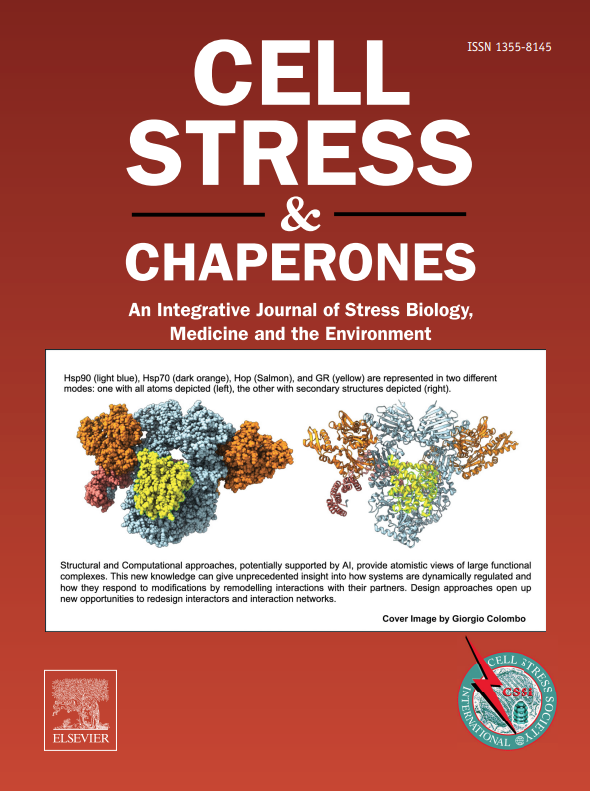犬睾丸对GnRH激动剂的分子反应:在精子发生停止和恢复过程中对AR、HIF-1α和HSPs表达的见解
IF 3.2
3区 生物学
Q3 CELL BIOLOGY
引用次数: 0
摘要
缓慢释放的促性腺激素释放激素(GnRH)激动剂植入物经常用于雄性犬的避孕。虽然这些影响是完全可逆的,但人们仍然担心植入物的作用方式的安全性。为了解决这个问题,我们研究了下调和恢复过程中的细胞应激和雄激素受体信号。从GnRH植入物移除后不同时间点去势的狗的睾丸组织中取样,并与未处理的对照组进行比较。采用qPCR方法检测雄激素受体(AR)、缺氧诱导因子1 (HIF1A)和热休克蛋白HSP72、HSP73、HSPA2、HSP90AA1和HSP90AB1,并用免疫组织化学方法检测AR、HSP72、HSP73和HSP90。AR、HIF1A和HSP70 mRNA水平上调,HSPA8、HSPA2和HSP90AA1 mRNA水平下调;HSP90AB1表达无明显变化。免疫组织化学证实ar在支持细胞、小管周围细胞和间质细胞中表达,偶尔也在精原细胞中表达。胁迫诱导型HSP72偶有检测到,而组成型HSP73和HSP90在生殖细胞中大量表达。我们的研究结果与松田鼠、鹅、鱼和鳖等季节性繁殖动物的研究结果相似。因此,与自然复发相比,GnRH植入物不会对睾丸细胞施加额外的细胞应激。由于HIF1α的比较数据缺乏,我们无法得出关于缺氧条件的结论。本文章由计算机程序翻译,如有差异,请以英文原文为准。
Molecular response of canine testis to GnRH agonist: Insights into AR, HIF-1α, and HSPs expression during arrest and recovery of spermatogenesis
Slow-release gonadotropin-releasing hormone (GnRH) agonist implants are frequently used for contraception in male dogs. Although the effects are fully reversible, there is still concern about the safety of the implant’s mode of action. Addressing this, we investigated cellular stress and androgen receptor (AR) signaling during downregulation and recovery. Testicular tissues were sampled from dogs castrated at different time points after GnRH implant removal and compared with untreated controls. AR, hypoxia-inducible factor 1 (HIF1A), heat shock proteins heat shock protein 72 (HSP72), heat shock protein 73 (heat shock cognate, HSPA8) (HSP73), heat shock protein A2 (HSPA2), heat shock protein 90 alpha (inducible isoform) (HSP90AA1), and heat shock protein 90 beta (constitutive isoform) (HSP90AB1) were investigated by quantitative real-time polymerase chain reaction and AR, HSP72, HSP73, and HSP90 immunohistochemically. While AR, HIF1A, and HSP70 were upregulated at gene expression level, HSPA8, HSPA2, and HSP90AA1 expression were downregulated during spermatogenic arrest; HSP90AB1 expression did not change. Immunohistochemistry verified AR-expression in Sertoli, peritubular, and Leydig cells, occasionally also in spermatogonia. Stress-inducible HSP72 was occasionally detected, while constitutive HSP73 and HSP90 were abundantly expressed by germ cells. Our results were similar to studies on seasonal breeders such as pine voles, geese, fish, and soft-shelled turtles. Accordingly, GnRH implants did not impose additional cellular stress on testicular cells when compared with natural recrudescence. Since comparative data on HIF1α are scarce, we cannot draw conclusions about hypoxic conditions.
求助全文
通过发布文献求助,成功后即可免费获取论文全文。
去求助
来源期刊

Cell Stress & Chaperones
生物-细胞生物学
CiteScore
7.60
自引率
2.60%
发文量
59
审稿时长
6-12 weeks
期刊介绍:
Cell Stress and Chaperones is an integrative journal that bridges the gap between laboratory model systems and natural populations. The journal captures the eclectic spirit of the cellular stress response field in a single, concentrated source of current information. Major emphasis is placed on the effects of climate change on individual species in the natural environment and their capacity to adapt. This emphasis expands our focus on stress biology and medicine by linking climate change effects to research on cellular stress responses of animals, micro-organisms and plants.
 求助内容:
求助内容: 应助结果提醒方式:
应助结果提醒方式:


